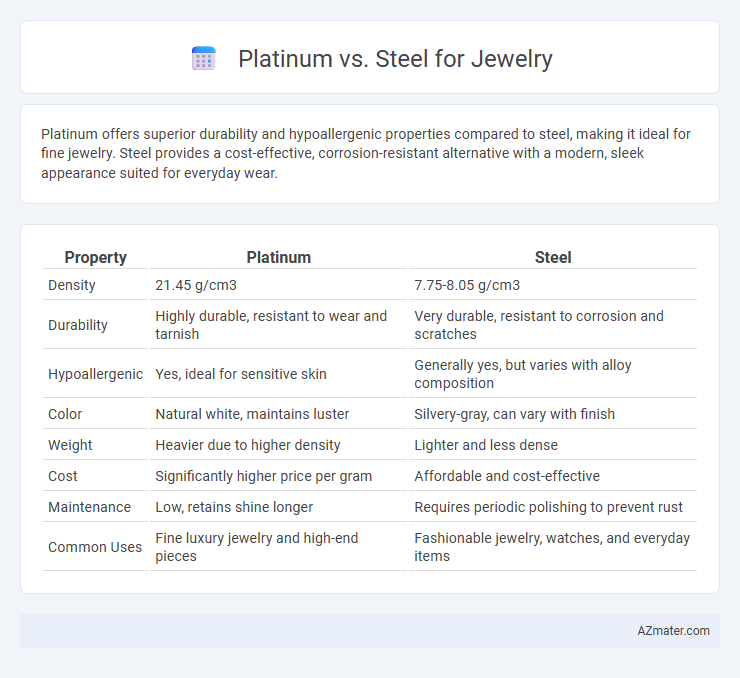Platinum offers superior durability and hypoallergenic properties compared to steel, making it ideal for fine jewelry. Steel provides a cost-effective, corrosion-resistant alternative with a modern, sleek appearance suited for everyday wear.
Table of Comparison
| Property | Platinum | Steel |
|---|---|---|
| Density | 21.45 g/cm3 | 7.75-8.05 g/cm3 |
| Durability | Highly durable, resistant to wear and tarnish | Very durable, resistant to corrosion and scratches |
| Hypoallergenic | Yes, ideal for sensitive skin | Generally yes, but varies with alloy composition |
| Color | Natural white, maintains luster | Silvery-gray, can vary with finish |
| Weight | Heavier due to higher density | Lighter and less dense |
| Cost | Significantly higher price per gram | Affordable and cost-effective |
| Maintenance | Low, retains shine longer | Requires periodic polishing to prevent rust |
| Common Uses | Fine luxury jewelry and high-end pieces | Fashionable jewelry, watches, and everyday items |
Introduction to Platinum and Steel in Jewelry
Platinum and steel are two prominent materials used in jewelry, each offering distinct qualities that influence durability and aesthetic appeal. Platinum is a dense, naturally white precious metal renowned for its rarity, hypoallergenic properties, and resistance to tarnish, making it ideal for luxury and fine jewelry such as engagement rings and wedding bands. Steel, particularly stainless steel, is favored for its strength, affordability, and corrosion resistance, often found in contemporary fashion pieces and men's jewelry due to its sleek and modern finish.
Key Differences Between Platinum and Steel
Platinum offers superior durability and natural white luster compared to steel, making it highly resistant to tarnish and corrosion. Steel, while more affordable and lightweight, lacks the hypoallergenic properties and prestige associated with platinum. The density of platinum is significantly higher, which contributes to its heavier feel and long-lasting wear in fine jewelry.
Composition and Purity: Platinum vs Steel
Platinum jewelry consists of 90-95% pure platinum, an element renowned for its natural white sheen and hypoallergenic properties, while steel jewelry is primarily composed of iron mixed with carbon and other metals, such as chromium, which forms stainless steel. The high purity of platinum ensures durability, resistance to tarnish, and a luxurious weight, whereas steel's alloy composition offers strength, affordability, and corrosion resistance but lacks the inherent precious metal value of platinum. Platinum's scarce purity and density make it a premium choice for fine jewelry compared to the more industrial and versatile use of steel.
Durability and Hardness Comparison
Platinum exhibits superior durability compared to steel, making it highly resistant to wear and tarnish over time, which is critical for fine jewelry. While steel ranks higher in hardness, offering excellent scratch resistance, its corrosion resistance is generally lower than platinum's, which naturally maintains its luster. Platinum's density also contributes to its robustness, ensuring jewelry pieces retain their shape and withstand daily wear better than most steel options.
Appearance and Luster: Which Shines Brighter?
Platinum jewelry offers a naturally white sheen that maintains its brightness over time without requiring rhodium plating, making it ideal for those seeking a lasting, luxurious luster. Steel jewelry, primarily stainless steel, shines with a reflective, silvery finish that is highly resistant to tarnishing but lacks the depth and richness of platinum's glow. While steel provides a durable and affordable shine, platinum's superior brilliance and weightier radiance make it the preferred choice for high-end, luminous jewelry pieces.
Hypoallergenic Properties and Skin Sensitivity
Platinum is renowned for its hypoallergenic properties, making it an ideal choice for individuals with sensitive skin or metal allergies, as it rarely causes irritation or allergic reactions. Steel, particularly surgical-grade stainless steel, is also hypoallergenic and resistant to tarnishing, but it may contain trace amounts of nickel, which can trigger sensitivity in some people. Choosing platinum ensures superior compatibility with sensitive skin, while high-quality steel offers a more budget-friendly option with decent hypoallergenic characteristics.
Weight and Comfort for Everyday Wear
Platinum jewelry is denser and heavier than steel, giving it a substantial, luxurious feel but potentially less comfort for all-day wear. Steel, especially stainless steel, is lightweight, hypoallergenic, and highly durable, making it a practical choice for everyday comfort. The choice between platinum and steel depends on balancing the desire for premium weight and prestige against the need for lighter, more comfortable daily wear.
Maintenance and Care Requirements
Platinum jewelry requires less frequent cleaning due to its naturally tarnish-resistant properties, making it highly durable and ideal for everyday wear. Steel jewelry is more prone to scratches and tarnish, necessitating regular polishing and cleaning to maintain its shine and appearance. Both metals benefit from gentle cleaning with mild soap and water, but platinum's density provides superior resistance to wear and deformation over time.
Price and Investment Value
Platinum jewelry commands a higher price than steel due to its rarity, durability, and hypoallergenic properties, making it a premium choice for luxury pieces. Steel, while affordable and resistant to tarnish, lacks the intrinsic value and long-term investment potential that platinum offers. Investors often favor platinum for its ability to retain and potentially appreciate in value, contrasting with steel's status as a low-cost, fashion-oriented metal.
Choosing the Best Metal: Platinum or Steel?
Platinum offers unparalleled durability and a naturally white sheen that resists tarnish, making it ideal for high-end jewelry requiring long-lasting brilliance. Stainless steel, while more affordable and resistant to scratches and corrosion, lacks the prestigious luster and weight that characterize platinum pieces. When choosing the best metal for jewelry, prioritize platinum for luxury and hypoallergenic properties, and stainless steel for budget-friendly, durable everyday styles.

Infographic: Platinum vs Steel for Jewelry
 azmater.com
azmater.com